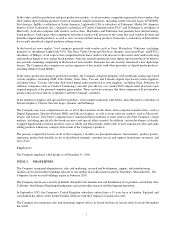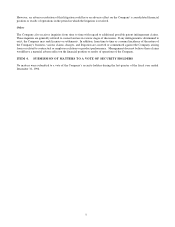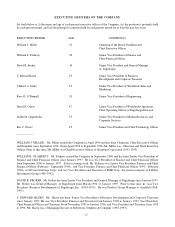Avid 1996 Annual Report Download - page 18
Download and view the complete annual report
Please find page 18 of the 1996 Avid annual report below. You can navigate through the pages in the report by either clicking on the pages listed below, or by using the keyword search tool below to find specific information within the annual report.17
that, if in default, it will be able to obtain such waivers. The Company had no borrowings against the line and was not in
default of any financial covenants as of December 31, 1996. The Company believes existing cash and marketable securities,
internally generated funds and available borrowings under its bank credit line will be sufficient to meet the Company’s cash
requirements, including capital expenditures, at least through the end of 1997. In the event the Company requires additional
financing the Company believes that it would be able to obtain such financing; however, there can be no assurance that it
would be successful in doing so, or that it could do so on terms favorable to the Company.
Certain Factors That May Affect Future Results
A number of uncertainties exist that could affect the Company’s future operating results, including, without limitation, the
following:
The Company’s gross margin has fluctuated, and may continue to fluctuate, based on factors such as the mix of products
sold, cost and the proportion of third-party hardware included in the systems sold by the Company, the distribution
channels through which products are sold, the timing of new product introductions, the offering of product and platform
upgrades, price discounts and other sales promotion programs, the volume of sales of aftermarket hardware products, the
costs of swapping or fixing products released to the market with errors or flaws, provisions for inventory obsolescence,
allocations of overhead costs to manufacturing and customer support costs to cost of goods, sales of third-party computer
hardware to its distributors, and competitive pressure on selling prices of products. The Company’s systems and software
products typically have higher gross margins than storage devices and product upgrades. Gross profit varies from product
to product depending primarily on the proportion and cost of third-party hardware included in each product. The Company,
from time to time, adds functionality and features to its systems. If such additions are accomplished through the use of
more, or more costly, third-party hardware, and if the Company does not increase the price of such systems to offset these
increased costs, the Company’s gross margins on such systems would be adversely affected.
The Company has recently initiated steps designed to shift an increasing proportion of its sales through indirect channels
such as distributors and resellers. The Company expects that this shift will result in an increase in the number of software
and circuit board “kits” sold through indirect channels in comparison with turnkey systems consisting of CPUs, monitors,
and peripheral devices including accompanying software and circuit boards sold by the Company through its direct sales
force to customers. Therefore, to the extent the Company increases its sales through indirect channels, its revenue per unit
sale will be less than it would have been had the same sale been made directly by the Company. In the event the
Company is unable to increase the volume of sales in order to offset this decrease in revenue per sale or is unable to reduce
its costs associated with such sales, profits could be adversely affected.
In 1995, the Company shipped server-based, all-digital broadcast newsroom systems to a limited number of beta sites.
These systems incorporate a variety of the Company’s products, as well as a significant amount of hardware purchased from
third parties, including computers purchased from Silicon Graphics, Inc. (“SGI”). Because some of the technology and
products in these systems were new and untested in live broadcast environments, the Company provided greater than normal
discounts to these initial customers. In addition, because some of the technology and products in these systems were new
and untested in live broadcast environments, the Company has incurred unexpected delays and greater than expected costs in
completing and supporting these initial installations to customers’ satisfaction. As a result, the Company expects that it
will report, in the aggregate, a loss on these sales, when all revenues and costs are recognized. In 1996, the Company
recognized approximately $3.3 million in revenues from three of these initial installations and approximately $3.6 million
of related costs. In future quarters, the Company expects to recognize an additional $5.0 million in revenues associated with
the remaining initial installations. The Company has provided a reserve for estimated costs in excess of anticipated
revenues. Revenues and costs are recognized upon acceptance of the systems by customers. The Company is unable to
determine whether and when the systems will be accepted. There can be no assurance that the remaining initial installations
will be accepted by customers or that the Company will not incur further costs in completing the installations. If
customers do not accept these systems, the Company could face additional costs associated with reducing the value of the
inventory included in the systems. The Company’s overall gross margin percentage will be reduced in any quarter or
quarters in which the remaining initial installations are recognized or written off. In 1996, the Company installed additional
server-based, all-digital broadcast newsroom systems at other customer sites. The Company believes that such installations,
when and if fully recognized as revenue on customer acceptance, would be profitable. However, the Company is unable to
determine whether and when the systems will be accepted. In any event, the Company believes that because of the high
proportion of third-party hardware, including computers and storage devices, included in such systems, that the gross
margins on such sales would be lower than the gross margins generally on the Company’s other systems.
























